Your bedroom color scheme is a chance to express yourself. It can turn your sleeping space into a cozy retreat. The right colors can make your room both stylish and comfortable.
Color affects our mood and well-being. Your bedroom’s palette sets the tone for rest. It should reflect your personality and promote peaceful sleep.
Consider your room’s orientation and natural light when choosing colors. North-facing rooms may need warm tones. South-facing spaces can use cooler shades.
Try mixing soft hues with bold accents. This can create a balanced and appealing look. Experimenting with color combinations can lead to exciting results.
Key Takeaways
- Bedroom color schemes greatly influence mood and sleep quality
- Room orientation affects color choices for optimal ambiance
- Mixing soft hues with bold accents creates visual interest
- Neutral colors provide a versatile foundation for bedroom palettes
- Personal preferences play a crucial role in selecting bedroom colors
- Experimenting with color samples helps in making informed decisions
The Psychology of Color in Bedrooms
Colors can transform your bedroom into a relaxing sanctuary or an energizing retreat. The right hues affect mood and sleep quality. Choosing colors that match your personality creates the perfect bedroom atmosphere.
How Colors Affect Mood and Sleep
Blue and green promote tranquility and better sleep in bedrooms. Blue lowers heart rate and blood pressure. Green represents harmony and balance.
Yellow and orange can boost mood and creativity. These energizing hues are great for creative spaces within your bedroom.

Choosing Colors Based on Personality
Your personality should guide your color choices. Introverts might prefer soothing shades like lavender or soft gray. Extroverts may opt for bolder hues in their bedroom design.
Think about how different colors make you feel. Choose bedroom colors that align with your emotions and preferences.
Cultural Influences on Color Preferences
Cultural background can impact color preferences. In feng shui, red symbolizes good fortune for bedrooms. White represents purity in Western cultures.
Consider these cultural nuances when selecting your bedroom palette. Your cultural background may influence your color choices.
“Colors are the smiles of nature.” – Leigh Hunt
Understanding color psychology helps create a beautiful and functional bedroom. Mood-enhancing colors promote well-being and restful sleep. Choose colors that reflect your personality and cultural background.
Calming Blues: Serenity in Every Shade
Blue paint colors offer relaxing options for bedrooms. From soft sky to deep navy tones, blue creates a peaceful sanctuary. Studies show blue rooms promote better sleep and lower stress levels.
Cool tones like Azure Tide and Swimming in Blue bring tranquility. These soothing hues pair well with crisp whites or natural wood elements. Bathe Blue, a mint-tinged shade, is perfect for beachy retreats.
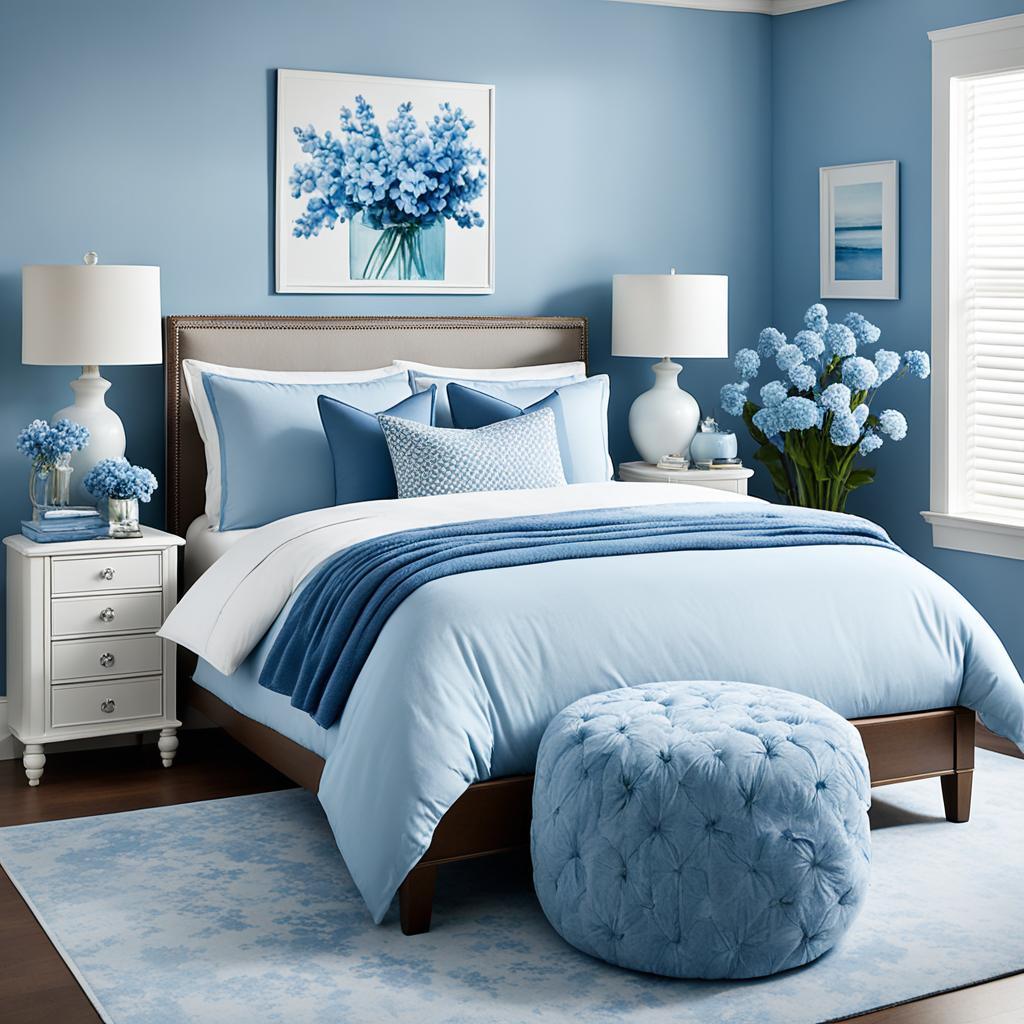
Deeper blues like Salty Dog or Loyal Blue envelop rooms in cozy comfort. These rich colors lower heart rate and blood pressure. They pair well with cream or gray accents for balance.
“People sleep better and longer in blue-painted rooms,” reports the Sleep Foundation.
Sea Salt by Sherwin-Williams offers versatile blue bedroom ideas. This chameleon-like color shifts between green, gray, and white. It’s a perfect backdrop for various decor styles.
| Blue Shade | Mood | Best Pairings |
|---|---|---|
| Azure Tide | Cozy | Cream, Gray |
| Swimming in Blue | Beachy | White, Sand |
| Salty Dog | Enveloping | White, Beige |
| Loyal Blue | Restful | Ivory, Taupe |
Blue offers endless possibilities for creating a serene sleep space. Light and airy or deep and dramatic, blue transforms bedrooms. Explore these relaxing paint colors to create your tranquil retreat.
Warm and Cozy: Earth Tones for Restful Nights
Earth tones are trending in bedroom design. They offer a mix of warmth and calm. These colors create a cozy space for better sleep and relaxation.
Terracotta and Ochre Palettes
Terracotta brings Mediterranean charm to bedrooms. It pairs well with ochre for an inviting, sophisticated look. Sage complements these colors, adding a calming touch.
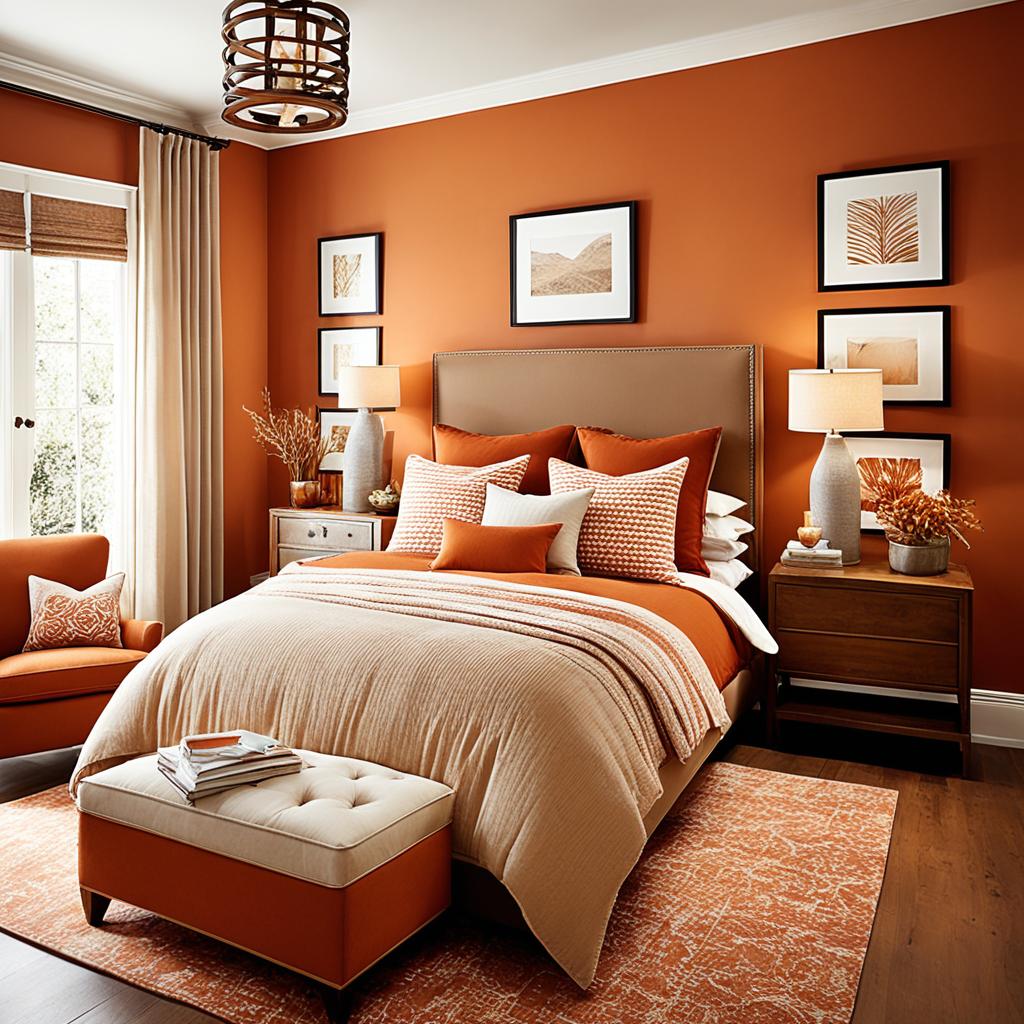
Incorporating Natural Wood Elements
Natural wood grounds an earthy bedroom palette. Wooden furniture or a reclaimed wood wall adds texture and depth. Pair these with leather, rattan, or linen for a layered, cozy feel.
Complementary Accent Colors
Balance warm bedroom colors with complementary accents. Brass or gold add elegance, while greenery brings life. For a bold look, try deep forest green or rich crimson.
| Earth Tone Palette | Accent Colors | Textures |
|---|---|---|
| Terracotta, Ochre, Sage | Gold, Forest Green | Wood, Linen, Leather |
| Camel, Brown, Ivory | Navy, Brass | Rattan, Jute, Shearling |
| Clay, Rust, Mustard | Olive, Black | Faux Fur, Wood, Cotton |
Combine these elements for a warm, inviting bedroom. Balance your earthy palette with complementary colors and textures. This creates a grounded, rejuvenating space for restful nights.
Luxurious Neutrals: Timeless Elegance
Neutral color palettes create timeless bedroom designs. These elegant colors offer a versatile foundation for various styles. They promote relaxation and tranquility, enhancing sleep quality.
Soft creams and gentle beiges create a serene atmosphere. These colors limit distractions and foster a peaceful environment. Neutral tones adapt well to different decor styles.
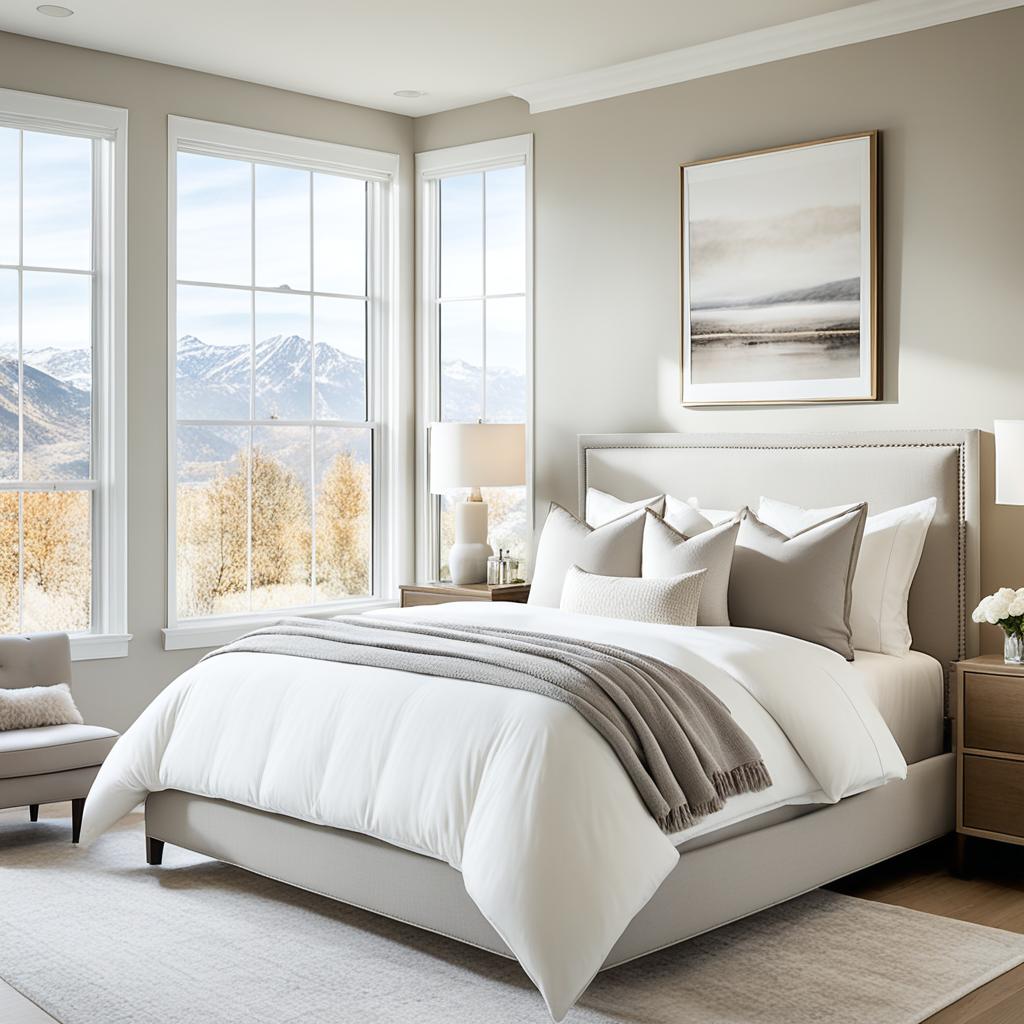
Consider the undertones when choosing neutral colors. Warm neutrals with red, orange, or yellow hints create coziness. Cool tones with green, blue, or violet offer serenity.
Natural light brings out the truest shades of neutrals. It softens the overall look of the room. Light adds gentle energy to the space.
Incorporate luxurious textures to elevate your neutral bedroom design. Velvet adds opulence, while linen brings a relaxed quality. Wool offers cozy warmth to the space.
Balance patterns with neutral colors for depth. Stripes and geometric prints on pillows or rugs add visual interest. These elements maintain the timeless elegance of your palette.
Crown molding around the ceiling adds sophistication. This classic element complements neutral color schemes beautifully. It enhances the overall elegance of the room.
Add pops of color to your neutral base. Warm terracotta oranges or rich spice tones infuse coziness. These colors add interest without overwhelming the space.
Careful selection of neutral colors creates a luxurious bedroom. Thoughtful design elements promote restful sleep. The result is an elegant style that stands the test of time.
Bedroom Color Schemes for Every Style
Your bedroom’s colors can change your space and show who you are. Different color sets fit various styles. Let’s look at some options for your room.
Modern Minimalist Palettes
Modern bedrooms focus on simple, elegant colors. Whites, grays, and beiges create a clean look. Soft accent colors add depth without being too much.
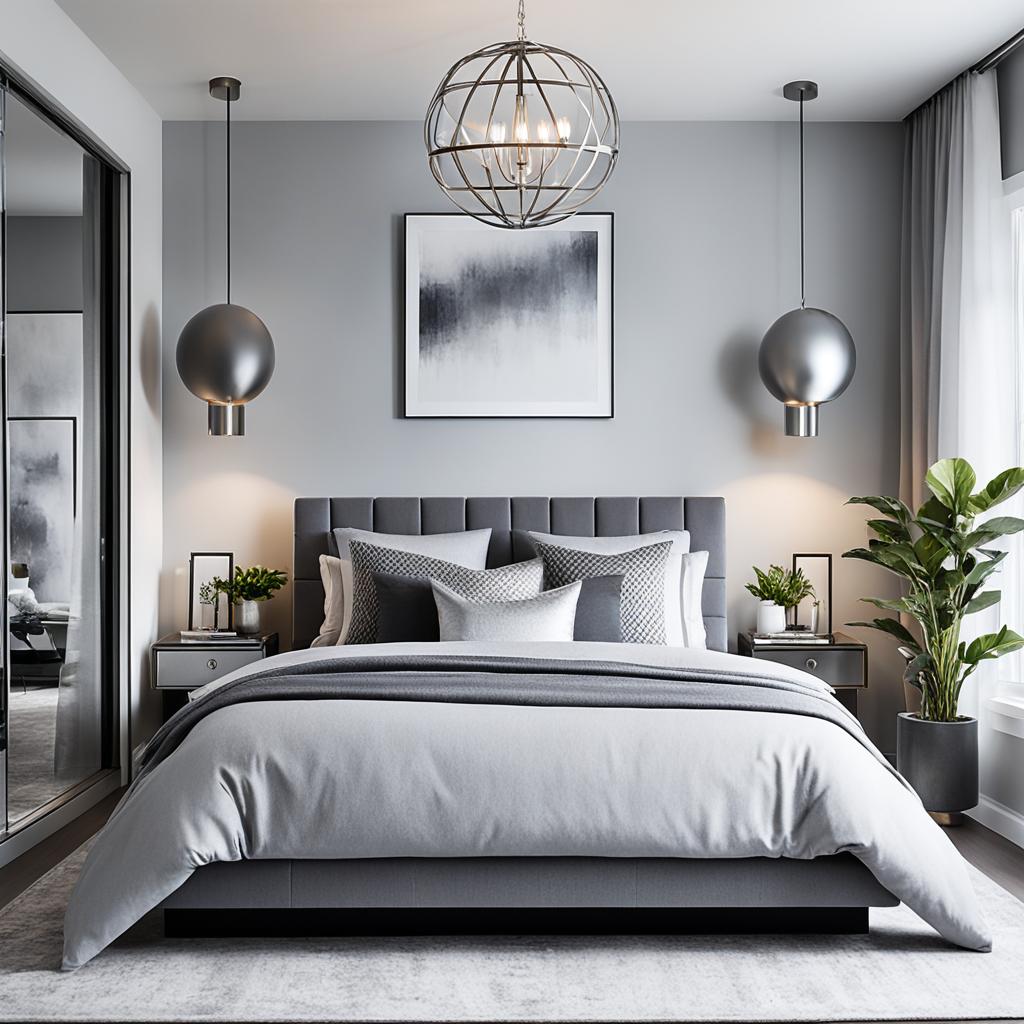
Bohemian Color Combinations
Boho bedrooms love bright, mixed colors. Rich greens, blues, and purples make rooms lively. Earth tones and warm oranges add a cozy feel.
Traditional Bedroom Color Schemes
Traditional bedrooms often use warm, welcoming colors. Soft pinks and greens give a timeless look. Deep blues or reds can add elegance.
Scandinavian-Inspired Color Choices
Scandinavian bedrooms use light colors to make rooms brighter. White is the main color. Soft grays and pale blues work well too. Wood accents warm up the cool colors.
| Style | Primary Colors | Accent Colors |
|---|---|---|
| Modern Minimalist | White, Gray, Beige | Muted Blues, Soft Greens |
| Bohemian | Jewel Tones, Earth Tones | Orange, Purple, Teal |
| Traditional | Pastels, Rich Hues | Navy Blue, Burgundy |
| Scandinavian | White, Light Gray | Pale Blue, Natural Wood |
These color ideas are just starting points. Mix and match to create a room that feels like you. Your bedroom should reflect your style and make you happy.
Bold and Beautiful: Statement Colors in the Bedroom
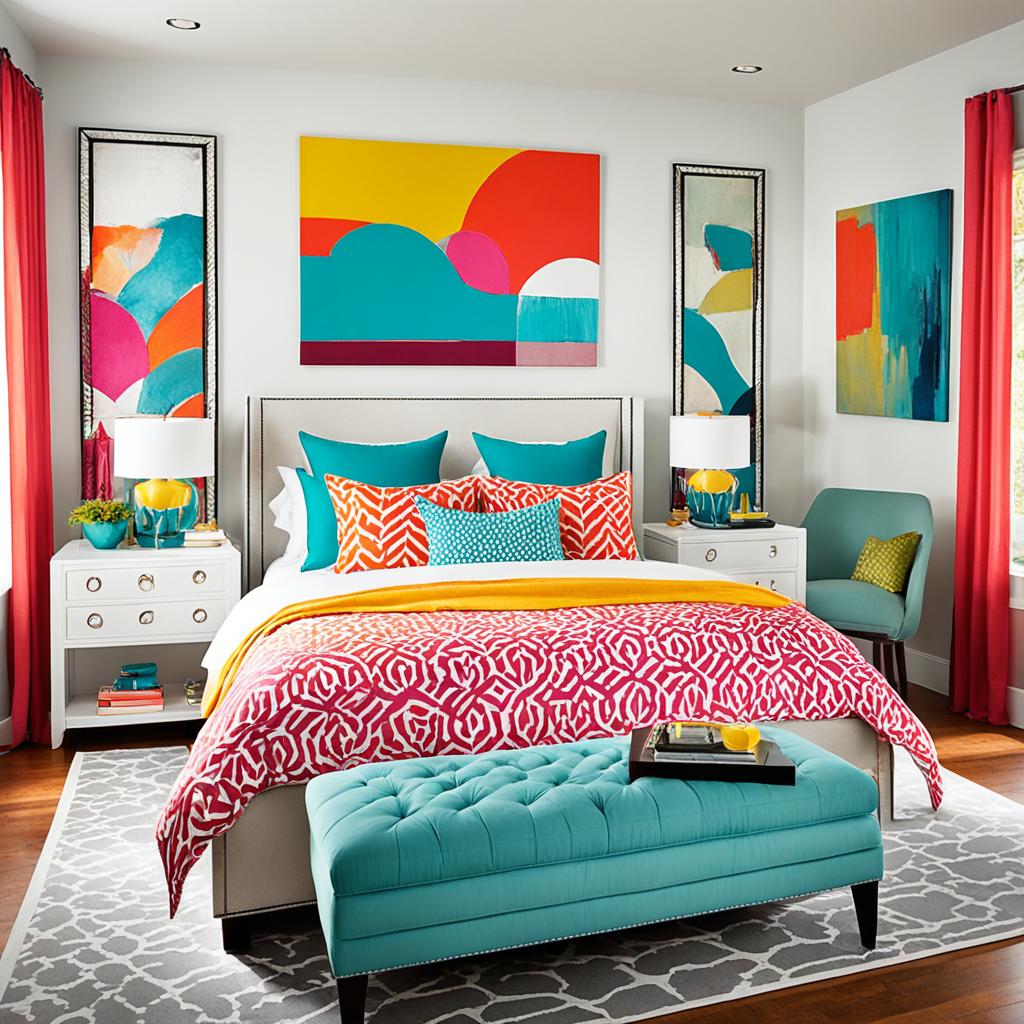
Transform your bedroom with bold colors. Create a vibrant space using daring choices and striking contrasts. Imagine an emerald green accent wall with crisp white linens.
Mix warm and cool tones for unexpected results. Pair soft blush pink with black and white for a luxurious feel. Or combine sandy browns, weathered whites, and oceanic blues for a beachy vibe.
Don’t fear vibrant hues like coral-orange or fuchsia. Use them as accents in neutral spaces. Add these colors through pillows, artwork, or a statement headboard.
“Color is a power which directly influences the soul.” – Wassily Kandinsky
For drama, try deep indigo-blue walls with warm parchment and cocoa brown accents. This rich combination creates a cozy, opulent atmosphere. Balance is crucial when using bold colors.
Include neutral elements to prevent overwhelming the space. Seek help from a professional decorator to navigate bold bedroom colors. They can guide you in creating a unique, striking, and harmonious bedroom.
Pastel Paradise: Soft Hues for Sweet Dreams
Pastel bedroom colors make a soothing oasis for restful nights. These soft hues can make small spaces feel larger and brighter. Let’s explore dreamy combinations for your sleep sanctuary.
Blush Pink and Sage Green Combinations
Blush pink bedrooms with sage green accents offer a fresh, nature-inspired look. This combo balances femininity with earthy tones. Use blush pink for walls and bedding, then add sage green throw pillows or curtains.
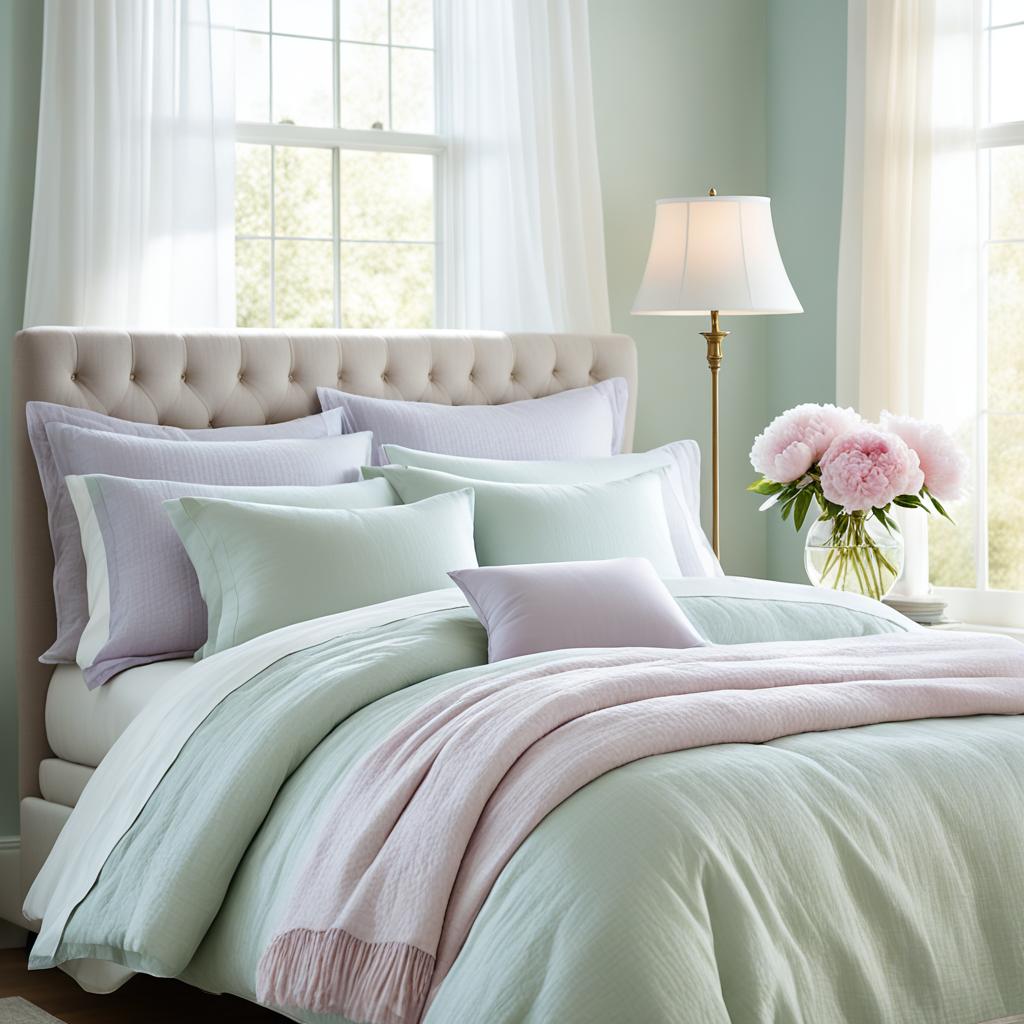
Lavender and Mint Pairings
Lavender and mint create a cool, calming palette. Paint walls in dusty lavender for a sophisticated look. Add mint green accessories to complete the soothing effect.
Creating Balance with Pastel Accents
Balance pastels with neutrals to avoid overwhelming your space. A white or light gray base lets pastel accents shine without dominating. Try pale yellow throw pillows on a neutral bedspread.
Hang artwork with soft blue hues on white walls for a subtle touch.
| Pastel Color | Effect | Best Paired With |
|---|---|---|
| Blush Pink | Warm, feminine | Sage Green, White |
| Sage Green | Fresh, natural | Blush Pink, Cream |
| Lavender | Calming, sophisticated | Mint, Light Gray |
| Pale Blue | Serene, spacious | White, Soft Yellow |
Pastel colors aren’t just for kids’ rooms. These soft hues create sophisticated, tranquil spaces for adults too. Try different combinations to find your perfect pastel paradise.
Monochromatic Magic: Tonal Bedroom Designs
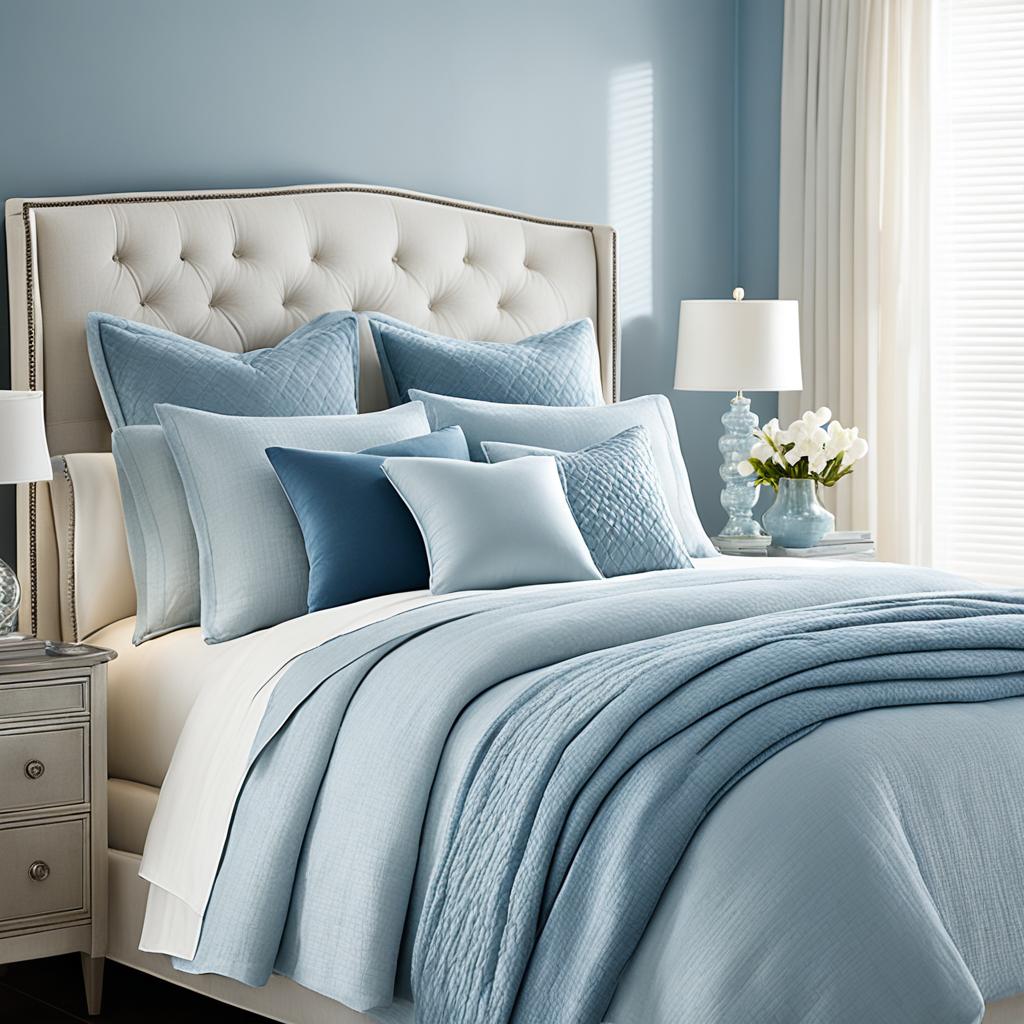
Monochromatic bedroom colors create a sophisticated look with minimal effort. This design uses different shades of one color for depth. Choosing three or four shades within the same color family creates a cohesive atmosphere.
Color harmony is crucial in monochromatic schemes. A purple bedroom can range from lilac to mauve for a stunning effect. Different textures within the same shade add visual interest while maintaining unity.
Consider these tips for monochromatic bedroom colors:
- Use a slightly deeper tone for focal points like headboards
- Introduce various tones in bedding, rugs, and wall art
- Add weathered woods for a casual, comfortable vibe
- Create contrast with bright whites against saturated colors
For a cozy feel, choose deeper, more saturated colors. Extend this theme into closets and bathrooms for a seamless look. Pinterest trends show interest in luxury bedroom palettes, including emerald green and gold combinations.
“Monochromatic designs create a cohesive and sophisticated look, perfect for those seeking a timeless color palette in their bedroom.”
Monochromatic color schemes are gaining popularity in 2024 bedroom design trends. They offer versatility and elegance for every style preference. Tonal bedroom designs work well for both modern luxury and cozy color palettes.
Color Blocking Techniques for Dynamic Bedrooms
Color blocking breathes new life into bedrooms. It uses bold colors to create visual interest and define spaces. Let’s explore exciting ways to use color blocking in your bedroom.
Two-Tone Wall Designs
Two-tone bedroom walls are a popular color blocking choice. This technique involves painting walls in two contrasting colors. It can make low ceilings appear higher or small rooms feel larger.
For a balanced look, pair a bold hue with a neutral shade. You can divide the colors horizontally or vertically on the wall.
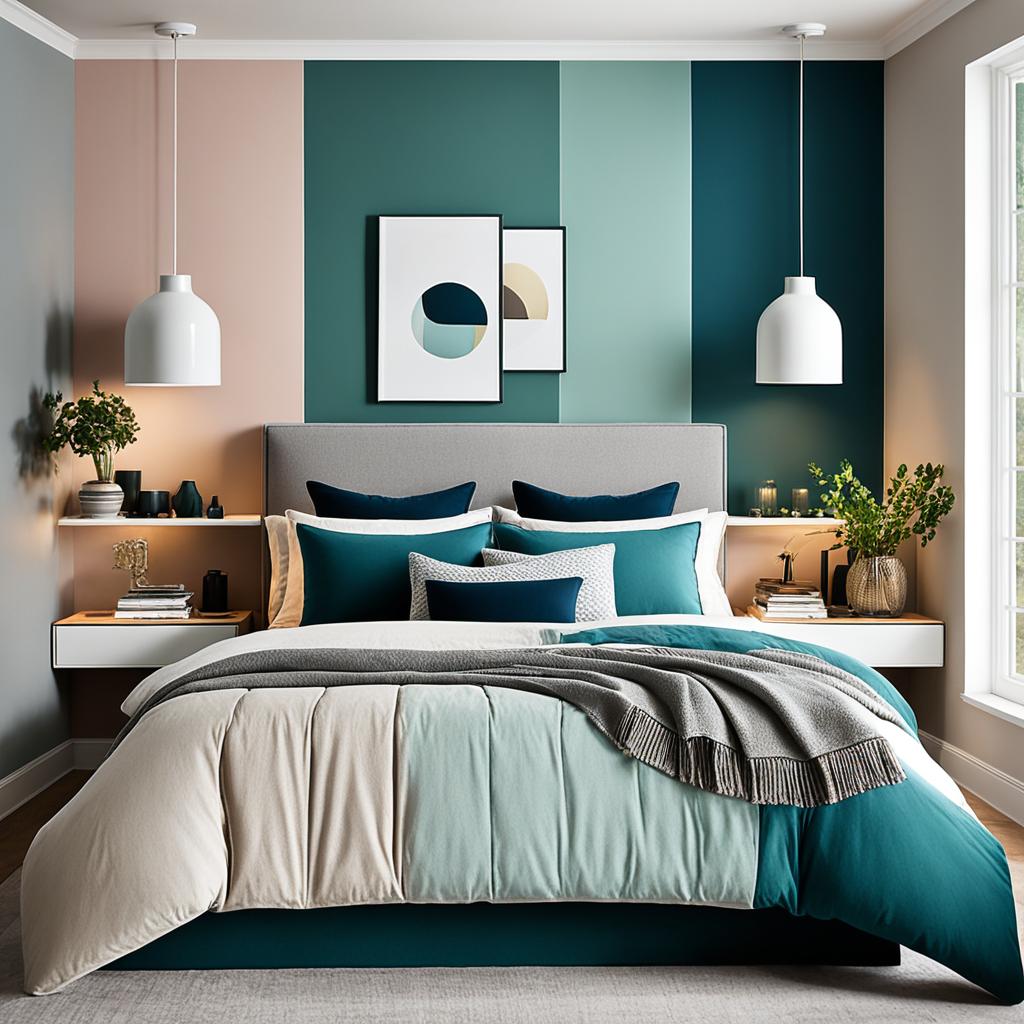
Colorful Accent Walls
Accent walls are great for introducing color blocking without overwhelming the space. Choose a vibrant color that complements your existing decor. You can create geometric shapes or abstract patterns on the accent wall.
Mixing Patterns and Solids
Pattern mixing in bedrooms adds depth to color-blocked spaces. Combine solid-colored walls with patterned bedding or curtains. Stick to a cohesive color palette to maintain harmony.
Here’s a simple guide for pattern mixing:
| Pattern Type | Best Paired With | Color Coordination |
|---|---|---|
| Large-scale floral | Small geometric print | Use colors from the floral in the geometric print |
| Stripes | Polka dots | Match stripe color with dot background |
| Abstract | Solid color blocks | Pull colors from the abstract pattern for blocks |
These color blocking techniques can transform your bedroom. Create a dynamic and personalized space that reflects your style. Let your creativity shine through your bedroom design.
Nature-Inspired Bedroom Color Palettes
Nature-inspired bedroom colors create a serene atmosphere for rest and relaxation. An organic color palette can transform your sleeping space into a tranquil retreat. It brings the peaceful essence of outdoor landscapes into your room.
Green bedroom ideas are popular, with shades from soft sage to deep moss. These hues promote tranquility and balance, making them ideal for bedrooms. Pairing them with natural wood elements and plants maximizes the calming effect.
Earthy bedroom colors like terracotta, putty, and khaki evoke rocky landscapes and sandy deserts. These warm tones create a cozy ambiance perfect for unwinding after a long day.
| Color Palette | Inspiration | Mood |
|---|---|---|
| Eucalyptus green, almond, chestnut | Forest floor | Calming, grounding |
| Turquoise, aqua, teal | Tropical waters | Refreshing, serene |
| Olive, stone gray, driftwood | Mediterranean landscape | Luxurious, earthy |
| Spearmint, aloe, white | Herb garden | Fresh, invigorating |
Nature-inspired wallpapers or murals can transport you to a serene forest or peaceful meadow. These elements enhance the overall atmosphere of your bedroom, creating an immersive experience.
“Nature’s palette is the ultimate inspiration for creating a restful bedroom environment.”
Lighting plays a crucial role in how these colors appear. Natural light enhances the organic feel of your space. Warm artificial lighting can create a cozy, nest-like atmosphere in the evening.
Lighting and Its Impact on Bedroom Colors
Bedroom lighting shapes how we see colors and create a restful atmosphere. Natural light varies based on room orientation, affecting color choices. South-facing rooms enjoy warm light all day, suiting various color schemes.
North-facing rooms benefit from yellow-based hues like Yellow Ground or New White. These colors help balance cooler light tones, creating a more inviting space.
Natural Light Considerations
East-facing bedrooms get bright morning sun, perfect for light blues and greens. These colors transition well into cooler evening light. West-facing rooms shine with warm tones like Middleton Pink.
These hues maximize the golden afternoon glow. Understanding natural lighting patterns helps choose the most flattering bedroom colors.
Artificial Lighting Solutions
Artificial lighting becomes crucial when natural light fades. Halogen and incandescent bulbs cast a warm, yellow light, enhancing cozy wall colors. Cool white bulbs provide bluer light, making colors appear cooler.
The right artificial lighting can dramatically change your bedroom’s color scheme and mood.
Color Temperature and Mood
Bedroom lighting’s color temperature affects wall appearance and overall mood. Warm lighting creates a cozy, relaxing atmosphere perfect for winding down. Cooler lighting can energize the space, making it suitable for daytime activities.
Color-changing bulbs can adjust the bedroom’s ambiance throughout the day. This aligns with your natural circadian rhythm and enhances your chosen color palette.
